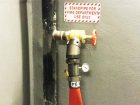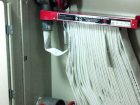
Features
Structural
Training
Back to Basics: September 2016
There are debates among fire service personnel about where firefighters should secure the standpipe in high-rise buildings. Some firefighters propose that the standpipe be secured on the fire floor while others advocate that crews hit the standpipe on the floor below the fire floor. There are considerations for both options that fire services need to understand before choosing one or the other.
August 29, 2016
By
Mark van
■ Securing on the fire floor
Easier hose advancement is the biggest advantage of securing the standpipe on the fire floor. Depending on the location of the fire and the location of the standpipe, choosing the fire floor will most often eliminate the short stretch.
The standpipe hook-up on the fire floor works the best when the standpipe is protected within a stairwell (see photo 1). The protection of the stairwell allows a team to secure the standpipe on the fire floor without interference from the unburned particles of combustion that may be accumulating on the fire floor. If the standpipe is located in the hallway of the building (see photo 2) and not in the stairwell, as many are in Ontario, then firefighters will potentially be exposed to an IDLH (immediately dangerous to life or health) environment; it will be difficult or dangerous for the team to make the connection.
Some proponents of a fire floor hook-up argue that it is effective particularly when the fire is contained in a high-rise unit, which means that there is no breach of the fire into the interior hallway. However, this is a dangerous thought process.
The fire service is based on what ifs. In this case, a crew is banking on the fire being contained, making it a nice, neat, simple fire to deal with; but what if it doesn’t? When have firefighters ever dealt with a nice, neat, simple fire in a high-rise situation?
There is a reason why apartment doors have automatic door closures: to try to keep a fire contained. But too often during a fire a door is left open, or is blocked open or is opened by another would-be rescuer and all of the sudden the fire spreads into the interior hallway.
A stairwell door that protects the standpipe, too, can be blocked open, wedged open, left open, or opened by another person, which causes the stairwell to fill with smoke.
■ Securing on the floor below
The main reason for securing the standpipe one floor below the fire floor is the protection and safety of the high-rise attack teams. The floor below the fire floor provides a safe haven for the team to gather, stage their equipment, get things set up and then make
the attack.
The floor below the fire floor is essentially a protected stairwell, whether or not the standpipe connection is in the hallway or in the stair shaft. Connecting to the standpipe at the floor below the fire floor allows the team to operate even if the fire breaches the apartment or unit, spreads down the hallway and is driven by wind, spreading fire at an aggressive rate.
The most important reason for the floor below hook-up is muscle memory. All firefighters are taught to follow a hoseline out of a dangerous situation, which, if they read the coupling correctly, will lead them to a pump panel. In the case of a high-rise building, firefighters will follow a hoseline out of the dangerous environment or situation to an area of refuge one floor below the fire.
If the hoseline is connected to the standpipe in the hallway on the fire floor, firefighters may struggle to find the exit. Even though building codes may require a standpipe in a hallway to be located within a certain distance from an exit doorway (see photo 3), that does not guarantee firefighters under stress will follow the hoseline back to the standpipe, then have the wherewithal to locate the nearest exit door to get out safely and quickly. Having the hoseline connected to the standpipe one floor below the fire guarantees that a firefighter following the line will find the stairwell.
Setting up on the floor below the fire before making an attack onto the fire floor also allows the initial attack team to breach an identical apartment unit to learn its layout. If the fire is in unit 505 and firefighters accesses unit 405, they should see the exact same unit. This strategy is an on-the-spot pre-plan if crews remember to do it.
So, in conclusion, when approaching a high-rise fire in a building equipped with standpipes, always secure the standpipe on the floor below the fire floor. Doing so will best protect crews and will provide a quick and direct path to a safe area. The short stretch of the hoseline can be overcome with other tactics such as the well stretch or with the addition of supply hose used as part of the high-rise kit. Read more about the well stretch and other tactics to overcome the short stretch in the August issue of Fire Fighting in Canada.
Mark van der Feyst has been in the fire service since 1999 and is a full-time firefighter in Ontario. Mark teaches in Canada, the United States and India. He is a local-level suppression instructor for the Pennsylvania State Fire Academy and an instructor for the Justice Institute of BC. He is also the lead author of Pennwell’s Residential Fire Rescue book. Email him at Mark@FireStarTraining.com
Print this page


